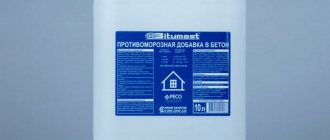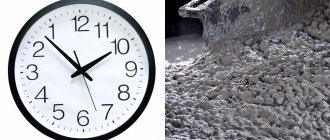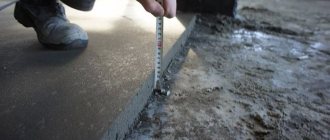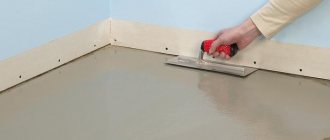Concrete strength gains on average within 28 days, and the full hardening period can be 3 years. During hardening, cement, reacting with water, forms monolithic compounds, which are similar in properties to artificial stone.
The speed and percentage of strength gain of concrete at normal temperatures is uneven. For example, after 3 days M300 gains 50% of the declared strength, after 2 weeks - 90%, and on the 28th day it hardens completely.
Table of strength development time by class and grade of concrete:
Graph of the strength gain of B15-B25 concrete in compression using Portland cement M400–M500:
The ripening process includes 2 stages:
- Initial - setting, which depends on air temperature and lasts from 20 minutes to 20 hours. The material takes the longest to set at a temperature of 0°C, and minus values negatively affect its strength after thawing.
- The final stage is hardening; after the end of the stage, the concrete can be loaded. The optimal temperature range is 18–20°C, humidity is approximately 100%. In the first 3 days, the strength gain of concrete is 30%, in the first 7–14 days - up to 70% of the brand value, and after 3 months - 90%. Concrete can gain strength for another three years.
Stages of concrete strength development
Essentially, there are only 2 stages:
- Setting of concrete.
- Durability set.
Setting of concrete occurs after a couple of hours. By eye you may notice that the composition becomes less mobile. The process ends after an hour, after which the strength gain begins. In some cases, the setting time of concrete can be extended. This often happens due to mixing too long/fast.
The time for concrete to gain strength can last up to a year. This depends on the environment as well as the composition.
Setting stage
Concrete begins to set within the first day. Temperature directly affects the curing time of the composition:
- Warm weather. In the summer, when the average temperature outside is +20-25 degrees, it only takes an hour to set. The process begins after 2 hours. The total setting time is 3 hours.
- Cool time. In the case of cooling and completion, the start and end times of this process shift slightly. Setting under such conditions takes about a day. When the temperature outside is zero, concrete begins to set after 6-10 hours from the moment the mixture is prepared. The process lasts 20 hours.
The mixture is still mobile at the first stage. During this time, it is easy to change the shape of the structure by exerting a mechanical effect on it. It is possible to prolong setting due to thixotropy (the ability of the composition to liquefy under mechanical stress). This mechanism allows the solution viscosity to be reduced. When the material is mixed in a concrete mixer, it can be preserved in the first stage much longer.
How long does it take to harden
It is impossible to accurately answer the question of how long concrete hardens in formwork. Typically, builders are guided by indicators from GOST - 28 days from the date of pouring. This is the estimated time during which the composition can gain relative strength for subsequent construction.
Please note that in the first month the composition is very capricious. The hardening time of concrete may increase noticeably in the event of any impact.
Curing time of concrete without additives
Hydration of pure concrete (cement + sand) under normal conditions depends on the class. Below is
times that you can focus on.
If you are asking the question: “how long can the foundation be loaded after pouring?” – usually this data is given on the packaging.
Factors affecting the hardening of cement mortar
In many ways, how long cement hardens is influenced by 3 variables: seasonality, compaction and composition.
Season
Environmental conditions also change depending on the season. In humid summers, the composition hardens much faster, because water can freely leave the composition. In winter, when the moisture in the air freezes and the temperature drops below 0, the hardening process can take 2-3 months.
Tamping
Tamping is the shrinkage of the concrete composition in the formwork. Those. packing as tightly as possible, which contributes to a faster hydration reaction.
Vibratory tamping is considered the most effective. In this case, excess air leaves the thickness of the fill, and unnecessary moisture rises to the top. This promotes faster setting even in unfavorable conditions.
Compound
Various additives can change the time the water comes out. For example, expanded clay and other porous materials can absorb moisture, which sharply slows down its release. Ordinary crushed stone or sand, on the contrary, speeds up this process.
Plasticizers also affect this. For example, liquid soap, PVA and bentonite also bind water, which slows down the evaporation of moisture. In addition, they complicate the cementation reaction.
Classification of concrete
There are several types of concrete based on their performance characteristics:
- compositions made from M50-800 cements are heavy;
- lightweight concrete that has porous aggregates (M50-450);
- cellular compositions, which include light and extra-light concrete (from M50 to M150).
The grade of concrete is established during the preparation of the project, which is necessary during the construction of the facility.
The increase in tensile strength of the material increases with increasing grade of cement in terms of compressive strength. Taking into account the area of use of concrete, both the brand and its strength class are determined. Concrete M50, M75 and M100 are considered the most unstable to loads. They are not used for critical structures.
When constructing houses that require increased foundation strength, M300 concrete is used. When creating a concrete screed, you can use the M200 composition. Cement products starting from M500 belong to the strongest category.
The difference in the strength of brands is explained by their constituent components. It is important to keep the proportions exactly. The best performance can be achieved by using a larger proportion of binder.
To convert a brand into a class, use the following formula:
B=(M*0.787)/10
Here B stands for class and M stands for brand. You can learn more about brands and classes from the table.
Methods for regulating the rate of concrete hardening
So, the hardening and drying time of concrete can be adjusted - and in both directions. This allows you to either reduce the time for construction work or move it to another time.
Acceleration of hardening
There are 3 ways to do this:
- Reducing the amount of water in the composition. In this case, the rigidity of the concrete increases, which reduces the drying time. You should not use this method, because... compaction becomes more difficult, and cementation worsens.
- Hot steam treatment. The method accelerates evaporation without leading to drying out. Unlike reducing the amount of water, the quality of concrete does not deteriorate, but the procedure is more expensive.
- Adding accelerators. The drying time of concrete with additives can be significantly reduced, but they tend to reduce strength.
Also, do not forget that the hardening of concrete varies depending on temperature. Filling in summer will harden 1.5 times faster than in autumn or spring.
You can speed up hardening in winter using the following methods:
- Installation of forced infrared heating.
- Laying reflective fabric. Some types of concrete, especially aluminous concrete, generate heat when hydrated, which can be sealed in the formwork with a reflective film.
- Chlorides. A class of substances that lower the pour point of water. This will solve the problem of liquid freezing in the thickness at deep minus temperatures.
Hardening slowdown
Slowing down is only possible with the help of special additives. This can be useful if the composition needs to be transferred to another location or during multi-stage filling.
You can also slow down the hydration process by increasing the proportion of water in the composition. You shouldn't do this, because... the quality of concrete may deteriorate, and in winter it may even lead to crystallization and cracks.
Recruitment process
Concrete is a popular stone material that is created from a mixture of water, binder and aggregate. It contains specialized additives that are responsible for special properties and functions.
During the hydration process, reliable monolithic compounds are formed, which acquire the properties of durable artificial stone. It takes several weeks (up to 28 days) to form a monolith, and obtaining factory quality takes up to 6 months.
The maturation of concrete consists of 2 stages:
- Grasping. Is the initial stage.
- Hardening. Finishing stage.
Knowing all the maturation standards, you can determine how many years a monolithic structure will last.
Grasping
The building material cannot be used immediately after pouring. Before doing this, you need to familiarize yourself with the schedule of concrete strength gain and the specifics of each stage of its maturation. Often the mixture is delivered to the construction site using special equipment, so it is kept in a moving state using automated equipment. Thixotropy technology maintains the basic consistency parameters until the moment of pouring, suspending natural ripening.
But if the mixture is kept for longer than the permissible time or exposed to high temperatures, the required performance properties will deteriorate. The concrete strength development chart mentions that it sets in a period of 20 minutes to 20 hours. If work is performed at sub-zero temperatures in winter, the term will increase to 6-10 hours.
To protect the structure from deformation, it is necessary to ensure the presence of warm formwork. Reinforced elements are thoroughly heated and cleared of ice. In summer, warm formwork is ineffective.
Some experts also use specialized additives and heat-insulating materials for winter work. When choosing this option, you need to familiarize yourself with their properties and instructions for use.
The following devices can be used to heat the mixture:
- Steam.
- Electric current.
- Lime-boiler.
- Exothermic cements.
- All kinds of accelerators.
Experts recommend starting pouring the solution into molds at +20°C. In this case, setting will occur in 1 hour and will take no more than 60 minutes. In hot weather, the process occurs almost instantly.
If grades M300 and M200 are used, and the ambient temperature is kept at +20 °C, the setting process will last for 1 hour.
Knowing how much concrete gains strength, you can correctly calculate the project implementation time and determine approximate financial costs.
Hardening
The next step is to harden the concrete mixture under the influence of hydration. The process involves the formation of new compounds from cement minerals. If there is no moisture in the solution, hardening will be slowed down or even stopped, which is why the material will not receive the required strength and will begin to crack.
At normal temperatures and a sufficient amount of liquid, the strength will constantly increase. Favorable conditions include a temperature of +20 °C and air humidity of at least 90%.
If such requirements are met, the process of increasing strength will take 7-14 days. During this period, the solution receives 60-70% of the declared strength, after which the process slows down.
When concrete is kept in water, its strength properties will be higher than when cured in air. A dry environment promotes rapid evaporation of moisture and stops the process. This is due to the fact that the grains of the cement mixture do not have time to enter hydration. Therefore, in order to avoid unpleasant consequences, it is necessary to prevent premature drying of concrete.
During the hardening process of the monolith, its volume constantly changes. The material also shrinks - in the surface zones it shrinks faster than in the inner part. If there is a lack of moisture during hardening, shrinkage cracks will appear on the surface of the concrete. Defects also occur when there is excessive heat generation.
The time it takes for concrete to gain strength also depends on the ambient temperature. At low levels the process slows down, and at high levels it speeds up.
If the structure being erected is subject to additional loads or there is a need to quickly dismantle the formwork, the hardening process will have to be accelerated. For such tasks, specialized additives are used. Their concentration is determined experimentally in a construction laboratory.
To achieve factory strength in a short time, it is necessary to properly maintain the solution and keep it moist, protecting it from shocks, impacts and damage. If not properly maintained, the material will become poor quality and vulnerable to cracking.
The key reason for the lack of strength is the low temperature that accompanies builders during winter concreting.
When exposed to cold, 2 problems arise:
- Slowing hydration and increasing recruitment time.
- Freezing of liquid from the concrete mixture, due to which the development of strength properties is suspended.
At low temperatures, the time required to obtain strength properties increases greatly, so special components are added to the feedstock.
In winter conditions, engineers use anti-freeze additives, which trigger recruitment processes and reduce the freezing point of the liquid substance.
If it is necessary to accelerate hardening at high temperatures or high humidity, the feedstock is heated. After pouring the mixture, the concrete surface must be reinforced with mats or shields that will keep the temperature from hydration and maintain the required conditions. If the filler freezes, it must not be used for further work.
Electrical heating of concrete is in demand on those construction sites where there is access to high-power transformers. Carrying out concrete work using electrical equipment is the best way to achieve factory strength without losing the performance of the material.
In winter, concrete is covered to protect the surface from heat loss.
Hardening time of concrete in formwork
The formwork limits the mobility of the composition, for this reason the speed of processes in it occurs faster. According to GOST, it can be removed when the concrete reaches 70% of its design strength, i.e. in about 7 days.
If durable concrete is not needed, for example, when building a barn or garage, the formwork can be removed after 3-4 days.
How long does it take concrete to harden in water?
Keeping in water is the most optimal according to GOST. With constant contact with moisture, concrete becomes more elastic. When ripening in air, the surface gradually shrinks and microcracks may form on the surface.
Solidification in water occurs with the same intensity as without it - 28 days.
It is worth noting that the amount of water should be moderate. Each brand and composition has its own humidity indicator - it is usually indicated on the packaging.
Daily schedule
Below is a graph of how concrete gains strength daily depending on temperature. It shows that in summer, when the air warms up to 25-35°C, the ripening time is reduced to 16-20 days. Please note that the concrete strength gain and hardening schedule does not take into account humidity.
If you are doing construction in winter, you will have to create artificial conditions for hardening.
For example, cover the formwork with reflective film and install infrared heaters. The use of wind blowers and fan heaters is not recommended, because they dry out the air and can cause cracks.
Humidity
Low humidity has a negative impact on the process of concrete hardening and strength gain. When there is little moisture in the air, cement hydration does not occur. As a result, the concrete hardening process does not occur.
High temperatures and humidity have a good effect on strength gain. At 70-90 degrees, strength increases rapidly. In this mode, the compositions are steamed in autoclaves at high pressure.
However, excessive heating of concrete will cause it to dry out and lose strength. This situation can be eliminated by moisturizing. In hot weather, concrete gains strength faster, so it is better to carry out work in the summer.
The optimal temperature for rapid hardening of concrete is 30 degrees. Under such conditions, the composition will gain 97% of the standard strength in 11 days. At five degrees, the stone will not reach a safe level even in 2 weeks. This requires heating and insulating the styling.
Table
The strength gain of concrete over the course of a day occurs non-linearly. It is most intense in the first 5 days, when hydration reaches 50%. Then the process gradually fades away.
Below is a table of concrete strength in MPA for classes 200 and 300. Unlike the graph, here you can see the hardness of the composition in percentage terms.
When to remove formwork
Removal of formwork can be carried out in case of urgent need for 3-5 days, but it is better to wait 7-14 days.
Well-set concrete that has gained 30-70% strength retains its shape and does not chip when disassembling the formwork. Stripping is permissible in the early stages if boards and boards are needed to perform work on another site or on the next object.
In private construction, it is reasonable not to rush and allow the mixture to gain the required strength indicators, which will take 2 weeks.











